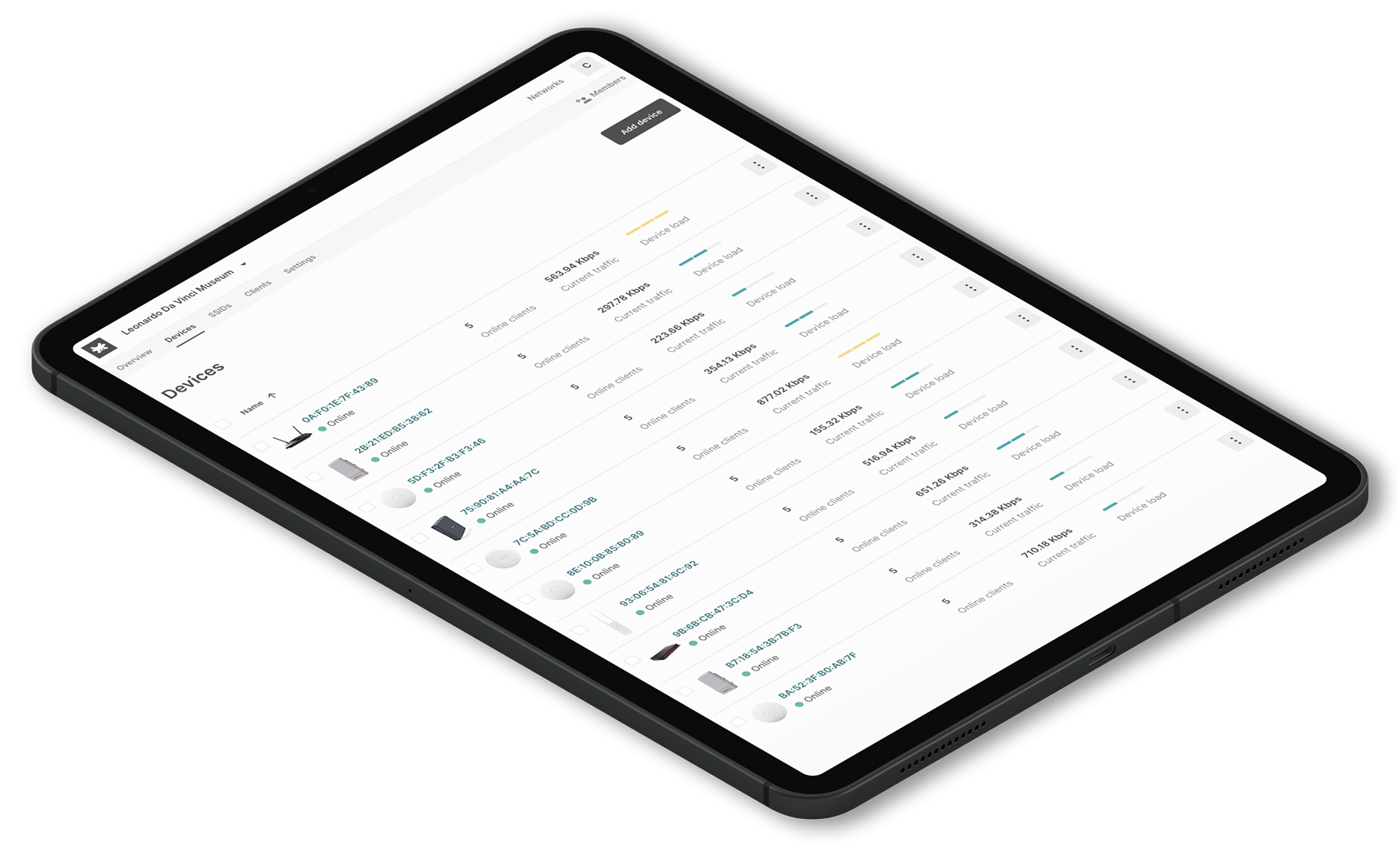
How to Optimize your WiFi Network Infrastructure
Press play to listen to the article.
This blog post will delve into the main 6 steps network administrators should undergo to design and implement future-proof, scalable, and reliable networks to effectively fulfill the data traffic demand.
1. Define the number of access points needed
First of all, you need to understand all the network requirements to provide a suitable design to avoid further site analysis and use additional access points after the WiFi infrastructure is deployed.
It is paramount to consider:
– what kind of applications will be handled in the network
– what technologies WiFi infrastructure will you support
– the number of devices that will connect to the WiFi network simultaneously
– where are the most relevant areas on the site that need WiFi coverage
Finally, consider power constraints: if you use PoE+, you are allowed to support higher performing access points.
If you want to calculate the number of access points for network deployments, please read our article Network Capacity Planning – Wireless Capacity vs. Coverage.
Tanaza supports a wide range of indoor and outdoor multi-vendor devices, and it has its cloud-managed line of Tanaza Powered Devices. You have the flexibility of choosing the most suitable brand of access points for your network deployments.
2. Control the WiFi network using a survey test
Furthermore, physical obstacles like trees, water, reflecting surfaces, building materials, or devices, like garage door openers, microwave ovens, cordless phones, and Bluetooth devices, are potential sources of interference that can negatively affect the WiFi network performance. By relying on the right network stumbler or survey tool with the capability of detecting coverage and capacity, you will be able to identify such interferences, solve these issues pretty quickly, and, accordingly, determine the best place where to deploy your access points. Also, knowing where your signals are and the adjacent APs is core to running your network secure and reliable.
Finding why your APs are performing badly can have the same effect as changing a channel or removing an object that produces interference.
The WiFi site survey is a fundamental component of the planning and design process before installing a new wireless network. However, it can also be used to check and improve existing infrastructures. Here are just some of the advantages of having a WiFi site survey:
- Identify and overcome potential issues before the installation rather than restore the equipment later on.
- Designing a made-to-measure network system is helpful to meet the specific WiFi needs of the business.
- Save time and money by avoiding bad choices that could have otherwise been made through a lack of important info.
- Choose the most efficient WiFi equipment for the size of the design.
- Give businesses the security that the option selected for the network’s plan has been the best to maintain a more reliable wireless network and expand performance levels.
Those types of tools will allow you to examine and analyze your WiFi networks to better plan, troubleshoot, and deploy them.
3. Monitor the WiFi network infrastructure
Usually, there should be a setup of bandwidth limits in any deployment location, so there’s a constraint on the data’s flow. For this reason, multiple devices allocated in a single area must share the bandwidth. Some devices request more bandwidth than others. That’s why greater bandwidth is necessary if proper speed must be maintained on different devices.
Tanaza, for instance, features an easy-to-use remote monitoring tool that effectively monitors bandwidth, by constantly checking upload and download speed, bandwidth utilization, and the devices’ load percentage.
In order to limit the bandwidth usage, Tanaza allows you to set up a maximum number of concurrent clients per SSID and the maximum bandwidth per SSID. Furthermore, our network monitoring software remotely checks the real-time status of your devices from a centralized dashboard and sends automatic and customizable alerts if it detects outages within your network. Furthermore, Tanaza’s platform guarantees high security and reliability levels by separating the encrypted management traffic and the client traffic on different networks.
If you want to know more about measuring bandwidth requirements, read this article: How to monitor bandwidth in WiFi Networks.
4. Enhance your WiFi infrastructure’s security
Different tools can help to prevent a WiFi network from malicious attacks.
The Internet is an environment that is easily exposed. To ensure greater network security, it is necessary to protect the Internet environment with the right encryption mechanisms. Therefore, creating a granular policy to ensure that users are protected from malicious and untrustworthy websites becomes essential in designing networks within high-density environments.
Web content filtering allows you to configure a content filtering system throughout the network to ensure users’ safe browsing. Thanks to this tool, businesses can block inappropriate websites’ navigation, for example, pornographic content, betting sites, and malware sites.
Identifying and implementing an easy-to-use authentication and encryption strategy will make your network more secure.
Operators can set up “user authentication” to control users’ access to the network.
Captive portals are often used for open wireless networks when authentication, payment, or acceptance of a license agreement or user policy is required.
A captive portal may be the right solution to control and manage broadband Internet access resources on the network facility. Also, paired with a Walled Garden, which can direct users’ navigation paths within particular areas to allow and/or prevent access to specific contents –typically used to restrict Internet access.
Tanaza features a built-in responsive and easy to set up splash page, allowing guest users to authenticate in seconds. You can access SSIDs with password encryption even in the presence of a captive portal. An access point can have from 1 to 8 SSIDs, and each one lands on a web page of your choosing, allowing you to view different splash pages to guarantee a different experience according to the needs of your business.
Tanaza gives the possibility to create a personalized Walled Garden to reach any domain you want. Suppose you select a list of websites that users can visit even without providing their personal data. In that case, Internet browsing is limited to a fixed number of pages, allowing everyone to access basic services without authentication.
5. Opt for a scalable network capacity
A scalable solution is an answer to meet the higher user-density demand. It will allow you to manage a given number of access points and later upgrade them when WiFi users’ density and the related data traffic increase. In this way, your WiFi network infrastructure can effectively handle an unlimited number of connected clients.
Remember that most access points support the latest technologies and maximum data rates defined as per the standards. However, the average access points’ throughput available is usually driven by other aspects like client device capabilities, concurrent users per access point, type of technologies to be supported, and bandwidth.
Most of all, client device capabilities can affect throughput as client devices supporting only standard technologies will have lower throughput than a client device supporting newer ones.
When assessing client device throughput requirements, you can run a survey on client devices to determine their wireless capabilities. In that survey, you should identify the supported wireless bands of those devices (e.g., 2.4 GHz vs. 5 GHz). Also, check on the supported wireless standards (802.11a/b/g/n/ac) and the number of spatial streams each device supports.
To ensure the quality of WiFi experience in a high-density environment:
- Make sure to have around 25 client devices per radio or 50 client devices per AP.
- Better having a channel width of 20 MHz to reduce the number of access points using the same channel.
- Client devices do not always support the fastest data rates. Therefore, based on the manufacturer’s advertised data rate, estimate the client device’s wireless throughput capability. A common practice is to consider about half of the data rate. Based on that value, reduce further the throughput by 30% for a 20 MHz channel width.
For instance, Tanaza benefits from unlimited scalability as it helps you manage from a few to thousands of access points, so you can scale networks when you need it. Therefore, it’s easier and faster for businesses to deploy WiFi networks.
Learn more about planning networks for capacity.
6. Improve your network’s frequency spectrum efficiency
There are different factors to consider that can help you choose the best frequency, depending on the network’s needs: interference and congestion.
Interference can slow down a network considerably, reduce its scope, and create congestion in the network. When multiple devices operate on the same frequency, there is usually interference that can affect the signal and reduce the connection speed. For this scenario, 2.4GHz is more convenient if you need to provide a better scope on your devices, have many walls or other objects where you need coverage.
Instead, the 5GHz band’s shorter waves make it less capable of going through walls and solid objects. In general, 5GHz WiFi frequency experiences fewer interferences from other devices than WiFi connections using 2.4GHz.
Therefore, if your WiFi network is located where there are many interferences from other devices, it will slow down your connection; thus, we would suggest steering your devices to the 5GHz frequency. If you install high-density deployments or locations with a high possibility of interference, choose dual-band devices or 5GHz devices, like the DCN WL8200-I2, DCN WL8200-I3, Comfast CF-WA350, all supported by Tanaza.
For example, Tanaza features an automatic channel selection tool that’s very useful when it comes to overlapping channels. Set the channel as “automatic,” and the system will consequently find and assign the best channel to your device each time it reboots.
Read more about selecting the right channel to avoid interferences in this blog post: 5GHz vs. 2.4GHz – What is the best WiFi frequency?
Try Tanaza
✔︎ No credit card required

Related articles:
https://www.tanaza.com/blog/how-to-monitor-bandwidth/


